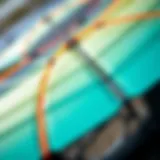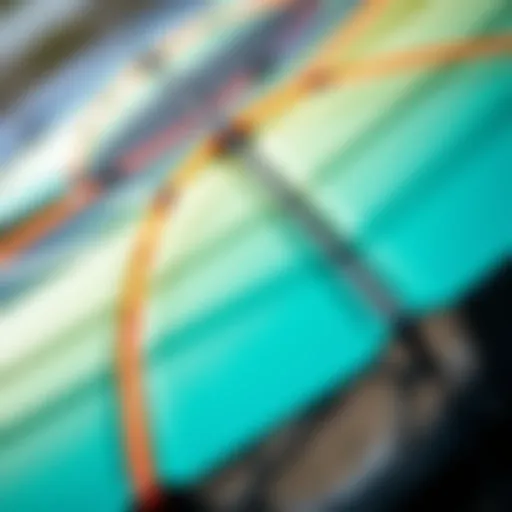Kiteboarding in Ponce Inlet: East Winds Explored
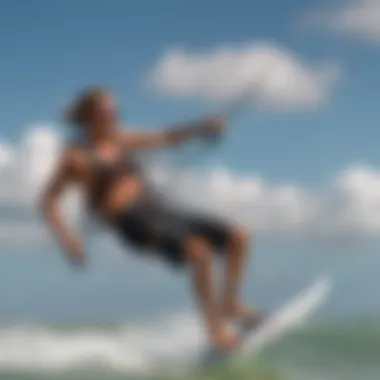

Intro
Ponce Inlet, Florida, stands as a beacon for kiteboarding enthusiasts, especially when the east winds fill the sails and send riders soaring across the water. These winds, characterized by their consistency and strength, create ideal conditions for both novice and seasoned kiteboarders. As we navigate through this vibrant locale, it becomes clear that the interplay of nature and sport is a fundamental part of the kiteboarding experience here.
The east winds in Ponce Inlet are not merely weather patterns; they are a catalyst for community. This article dives headfirst into the characteristics of these winds, their influence on kiteboarding, and essential safety tips that every rider ought to heed. We'll also venture into the heart of the local kiteboarding culture, showcasing not just the thrill of the ride but also the camaraderie that comes with this exhilarating sport.
As we embark on this exploration, we’ll break down techniques suited for various skill levels, review the latest gear that has hit the market, and underline the essential accessories that make every session enjoyable and safe. Whether you're looking to refine your skills, understand the intricate dance of the winds, or simply soak in the local scene, there’s something here for everyone.
Let’s get started!
Preface to East Winds in Ponce Inlet, Florida
Ponce Inlet, with its serene waters and striking landscapes, offers kiteboarders more than just a picturesque locale. At the heart of this thriving kiteboarding scene lies the east winds—an essential factor that dictates not only the experience of riding but also the safety and skill development of every enthusiast.
The east winds, often regarded as the lifeblood of kiteboarding in this region, significantly enhance the sport's appeal. They usher in consistent wind conditions that are generally favorable for both beginners and seasoned riders. When the winds blow just right, the waters of Ponce Inlet become a playground where kiteboarders can hone their skills, enjoy exhilarating rides, and even push boundaries of what is possible on the water.
Understanding these winds is key. For lovers of adrenaline, the feeling of soaring above the water, propelled by the wind, is unparalleled. Kiteboarders often seek out sites and times when east winds are predicted, making knowledge about these winds a valuable asset.
Moreover, the interplay between wind patterns and skill levels cannot be overstated.
East winds behave consistently, allowing those new to the sport to learn at a steady pace, while providing challenges for advanced practitioners.
"Without the right wind, kiteboarding lacks the very essence that draws people to it."
Apart from performance, there’s a community aspect to these winds. Local kiteboarding culture thrives on shared experiences in varying wind conditions, creating bonds among enthusiasts and instructors alike. This collective appreciation of the winds adds to the richness of kiteboarding here.
In this article, we will explore how the east winds influence various elements of kiteboarding, from wind patterns to gear suitability. We’ll dig into everything—be it tips for navigating local conditions or insights on community events—all tailored for kiteboarders, instructors, marketers, and travel agents looking to immerse themselves in this breathtaking paradise.
Geographical Overview of Ponce Inlet
Understanding the geographical layout of Ponce Inlet is fundamental to appreciating the unique kiteboarding conditions it offers. This small coastal community, nestled between New Smyrna Beach and Daytona Beach, boasts a mix of landscapes that create captivating wind patterns ideal for the sport. The mixing of coastal and inland geographic features in this area plays a central role in the intensity and direction of these winds, making it a hotspot for kiteboarders.
Location and Landscape
Ponce Inlet is a gem on the central Florida coast, characterized by its distinct coastal features and lush nature trails. It’s flanked by the vast Atlantic Ocean to the east and the tranquil Indian River Lagoon to the west. This juxtaposition is not merely picturesque; it creates a microclimate that produces highly favorable kiteboarding conditions.
The area’s sandy beaches, extensive marshes, and foliage-heavy dunes provide a backdrop that is incredibly important for wind generation and direction change. These natural elements work together to either channel or disrupt winds, making each kiteboarding session unique.
Adding to its charm, the Ponce de Leon Inlet Lighthouse, an iconic structure, stands tall as a beacon not just for navigators but also for kiteboarders. The landscape here is more than a canvas; it plays an active role in the dynamics of kiteboarding, making it essential for enthusiasts to take stock of the natural contours as they plan their rides.
Proximity to Major Kiteboarding Areas
Ponce Inlet is also strategically located near some of the most renowned kiteboarding spots in Florida. The proximity to these locations dramatically enhances its attractiveness for both new and seasoned riders. Here are a few factors to consider:
- Accessibility: The ease of getting to nearby beaches, such as those in New Smyrna Beach and Daytona Beach, which are known for their consistent winds and vast open spaces.
- Community: Being close to these hotspots means easy communication and interaction with other kiteboarding enthusiasts. Whether it’s sharing tips or organizing group outings, shared locations foster a tight-knit community.
- Event Hosting: Major kiteboarding events and competitions regularly occur in adjacent areas, allowing Ponce Inlet to serve as an ideal hub for participants and spectators alike.
As you navigate the waters and air of Ponce Inlet, consider not just the direct influence of the east winds, but how the geographical nuances interact to create a kiteboarding haven. Understanding this layout gives kiteboarders an edge, helping them adapt their techniques and gear for the ever-changing natural environment.
Understanding Wind Patterns
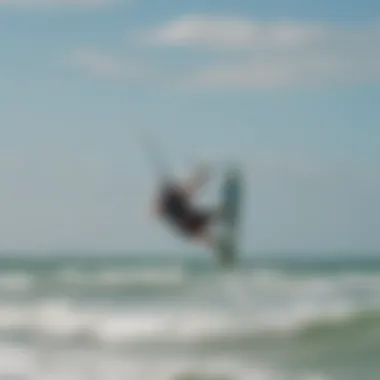

Grasping the intricacies of wind patterns is critical for any kiteboarder aiming to master the art of riding the waves in Ponce Inlet. East winds, in particular, possess unique characteristics that shape both the experience and techniques employed by kiteboarders in this region. Wind direction and speed directly influence the conditions on the water, creating either a serene landscape for beginners or a thrilling arena for seasoned riders.
By acknowledging the wind's behavior, riders can effectively tailor their gear choices and maneuvering techniques to harness its power. A well-informed kiteboarder stands at an advantage, capable of predicting favorable conditions and making strategic choices that lead to enhanced performance.
Wind Direction and Speed
East winds typically offer a consistent flow, often described as a steady presence on the horizon. Generally, these winds originate from the Atlantic Ocean, creating ideal conditions for those looking to ride the challenging waters of Ponce Inlet. The wind's speed, frequently clocked at between 10 to 20 knots, can significantly influence the stability and control a kiteboarder has during their session.
For beginners, understanding this relationship is fundamental. It's not just about how fast the wind blows; it's about how that speed interacts with the kite and board. Knowing when to launch and the type of kite to use becomes vital for safety.
"Understanding wind dynamics can turn a mediocre session into an exhilarating ride. The beach becomes a classroom when you know the winds."
Seasonal Variations
The kiteboarding scene in Ponce Inlet is not static; it evolves with the seasons. As the temperatures shift, so does the behavior of the east winds. During the spring and summer months, these winds tend to be more robust, providing consistent and varied conditions that appeal to kiteboarders of all skill levels. The arrival of fall may usher in softer winds, while winter can present challenges with unpredictable gusts.
Riders need to adapt their techniques with the seasonal changes. For instance:
- Spring and Summer: Ideal for dynamic maneuvers and tricks, as the winds provide the lift required for jumps and aerials.
- Fall: Conditions can be variable; kiteboarders may need to adjust their gear and approach based on the day's unique wind patterns.
- Winter: While it can be less predictable, venturing out can lead to some exhilarating sessions if one understands the local conditions well.
In summary, a kiteboarder's awareness of the wind's direction, speed, and seasonal behaviors will serve as a cornerstone for successfully navigating and enjoying the vibrant waters of Ponce Inlet.
The Role of East Winds in Kiteboarding
When it comes to kiteboarding, understanding the role of east winds is crucial. These winds, prevalent in Ponce Inlet, not only set the stage for the kiteboarding experience but also directly influence performance and safety on the water. Without a firm grasp of how these winds behave, both beginners and advanced riders might find themselves in a world of trouble or, worse, missing out on the thrill of an ideal session.
Optimizing Kite Performance
East winds are known for their steadiness, which can be a kiteboarder’s best friend. These winds usually blow at moderate speeds, allowing riders to optimize their kite performance. The consistent airflow helps ensure that kites remain airborne with little strain, maximizing lift while minimizing fatigue.
To get the utmost out of these winds, consider the type of kite used. For instance, a larger kite is often more advantageous in lighter winds while a smaller one should be your go-to for stronger blows. Riders can tweak their lines and adjust their setup to match the wind conditions.
Here are some considerations to optimize kite performance:
- Choose the Right Kite Size: Understanding the wind speed can influence the kite size, which is vital for optimal performance.
- Adjust Line Length: Shorter lines can offer more power, while longer lines give more speed; knowing when to adjust can enhance the ride.
- Body Position: Low stances can help keep balance against the east winds.
"Finding that sweet spot in the east winds isn’t just about skill; it’s about adapting to nature’s rhythm."
Ideal Conditions for Beginners
For those just starting their kiteboarding journey, east winds in Ponce Inlet create near-perfect learning conditions. Their predictability allows instructors to focus on guiding newcomers through the fundamentals without worrying about sudden gusts or lulls that could disrupt learning.
Some fundamental aspects of kiteboarding in this wind include:
- Gentle Yet Consistent: The winds can offer an easy-going ride, especially for beginners trying to figure out their balance and kite control.
- Lesser Risks: The steadiness reduces the chances of accidents, making it an excellent environment to practice maneuvers without heightened worries.
- Wider Learning Opportunities: Riders can get a feel for various exercises early on, like body dragging and board starts, with confidence stemming from stable winds.
Advanced Techniques in Stronger Winds
As kiteboarders progress, they’ll eventually seek out stronger winds to hone their skills further. East winds can vary, offering days with a bit more punch where seasoned riders can showcase advanced techniques. The key lies in both recognizing and respecting the intensity of these winds.
For advanced riders, here are some techniques to consider in stronger winds:
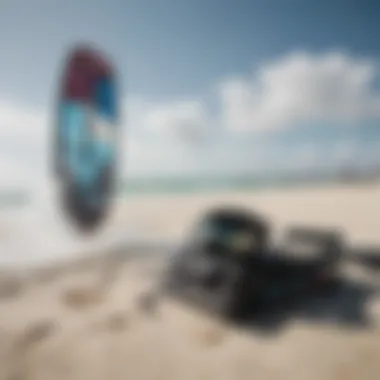

- Riding Unhooked: Stronger winds allow for unhooked tricks, providing the capacity to push boundaries quickly.
- Jumping Higher: Wind power can help propel jumps, enabling riders to explore aerial maneuvers with more ease.
- Speed Control: Mastering handling speed in stronger winds requires finesse, so be ready to shift weight and manage momentum.
Local Kiteboarding Culture
Kiteboarding in Ponce Inlet is more than just a sport; it embodies a vibrant culture that unites locals and visitors alike under the banners of wind and sea. The inhabitants here share a passion for adventure, pushing the limits of what is possible on the water while cherishing the serene beauty of their surroundings. This culture isn't merely confined to the act of kiteboarding itself but extends to the community, events, and interactions that define the spirit of this breathtaking locale.
Community and Events
In Ponce Inlet, kiteboarding events dot the calendar, from local competitions to social gatherings that bring together enthusiasts from all walks of life. Events like the Ponce Inlet Kite Fest serve as a platform for both seasoned riders and newcomers to showcase their skills and learn from one another. These occasions engender a sense of camaraderie, fostering friendships that transcend the sport itself. Many of these gatherings promote environmental awareness, teaching participants about the local ecosystem and how to engage with it responsibly.
Notably, kiteboarding workshops and clinics hold significant value within this community. By attending, novice kiteboarders can find mentorship from experienced riders who are eager to share tricks and tips gained through countless hours on the water. These interactions are invaluable, building a supportive network that encourages growth and safety. At the same time, it promotes a healthy competition that uplifts everyone's skills.
"Kiteboarding here feels like being part of a family, with everyone cheering each other on, whether you’re a pro or just starting out. It’s the joy of the sport that brings us all together."
— A local kiteboarding instructor
Interactions with Local Instructors
Local instructors are the backbone of Ponce Inlet’s kiteboarding culture. With a wealth of experience, they provide crucial guidance to those trying to grasp the nuances of the sport. Their role extends beyond just teaching techniques; they inspire confidence, ensuring students feel empowered on the water. These mentors understand the unique wind patterns of Ponce Inlet and share this knowledge with their students, helping them navigate the sometimes unpredictable conditions with ease.
Moreover, most instructors cultivate a friendly rapport with their students, making lessons engaging and enjoyable. They often keep things light, emphasizing the need for safety and respect towards fellow riders, wildlife, and the coastal environment. The dedication of these instructors fosters a sense of loyalty among students who often return for advanced lessons or workshops.
In essence, the interactions between local instructors and kiteboarders elevate the overall experience in Ponce Inlet. Whether you're learning the ropes or looking to master a new trick, the supportive nature of this culture cannot be overstated. The nuances they teach go far beyond technical skills; they instill respect for the craft and the environment, leading to responsible kiteboarding behaviors that become a part of the life lessons learned on the waves.
Safety and Environmental Considerations
Kiteboarding in Ponce Inlet brings with it a whirlwind of excitement, but it’s vital to keep safety and environmental health at the forefront of our minds. Understanding the myriad of factors that can affect both kiteboarders and the delicate ecosystem of the area is essential for anyone looking to experience the thrill of east winds. This section will dive into the local hazards and the environmental impact of the sport, highlighting necessary precautions and sustainable practices to ensure that kiteboarding remains enjoyable for generations to come.
Understanding Local Hazards
Ponce Inlet’s stunning coastlines and inviting waters are tempting for kiteboarders, yet they hide some potential hazards that could lead to serious incidents. Here are some factors to keep in mind:
- Strong currents: The ocean can be unpredictable. Before hitting the water, kiteboarders should familiarize themselves with tide charts and any existing current information. Knowing how tides change can help navigate through tricky waters.
- Obstacles: Unseen underwater rocks, sandbars, and jetty structures can create troubles if one is not careful. Always stay alert and consider scouting the water first. Seeing is believing.
- Weather changes: East winds can coax in sudden weather shifts. Storms can roll in quickly, leading to dangerous conditions on the water. Monitoring weather apps or local forecasts can keep you one step ahead.
- Local wildlife: While spotting dolphins and sea turtles might be a highlight, be cautious of other marine creatures. Jellyfish, for example, can pose a sting risk if one accidentally brushes against them, so staying aware of their seasonal patterns is paramount.
"Understanding your surroundings is half the battle of kiteboarding success."
By being proactive about these hazards, kiteboarders can not only enhance their own safety but also show respect for those sharing the waters.
Environmental Impact of Kiteboarding
As ontogeny recedes due to climate change, it’s crucial to consider how kiteboarding impacts Ponce Inlet's environment. While the thrill of kiteboarding is undeniable, ensuring this sport doesn’t compromise the natural beauty of Ponce Inlet is essential. Here are a few key points regarding its environmental footprint:
- Wildlife disturbance: Kiteboarding can disturb nesting birds and other wildlife. Avoiding areas where these creatures dwell, especially during crucial nesting seasons, is key to protecting them.
- Erosion: Repeated visits to the same launch and landing spots can cause erosion, particularly along sand dunes. Rotating launch locations and being mindful of where one sets up can alleviate some of this pressure.
- Littering: The thrill of kiteboarding shouldn't come with a trash trail. Kiteboarders should always pick up after themselves to keep beaches clean and enjoyable. Consider having a trash bag handy, 'because if everyone does their bit, it adds up.'
- Sustainable practices: Locally, encouraging eco-friendly practices like using sustainably made gear can help reduce the sport's carbon footprint. Using biodegradable kites and participating in beach clean-up events not only fosters community but also shows responsibility towards the environment.
Kiteboarding Gear Suitable for East Winds
Kiteboarding is not just a sport; it’s an experience, especially when the east winds of Ponce Inlet come into play. Selecting the right gear is crucial for maximizing the adventure while ensuring safety and performance. This section dives deep into the specific elements that kiteboarders should consider, the benefits of tailored gear, and how each piece contributes to a satisfying ride.
Types of Kites for Varied Conditions
Choosing the right kite can make all the difference when battling the breezy stretches of Ponce Inlet. The versatility of kites allows riders to adapt to varying wind conditions, a feature that is essential when the east winds blow strong.
- Bow Kites: These kites are particularly effective in lighter wind conditions. Their design enables a larger surface area, providing excellent lift and stability. Kiteboarders, from novices to advanced riders, can benefit from their predictable handling.
- C-Kites: If the winds kick up, the C-kites shine. They offer superior performance for jumping and trickery, appealing to the high-flying crowd. Their direct steering and power allow for aggressive maneuvers that seasoned kiteboarders revel in.
- Delta Kites: These blend stability with versatility, making them a go-to for varying conditions. The greater aspect ratio and efficient design help riders maintain flight even when the wind shifts.
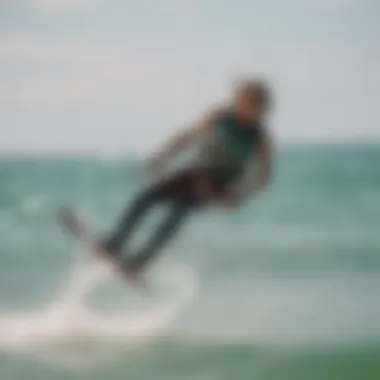

Kite choice directly influences a rider’s performance; therefore, understanding the wind patterns in Ponce Inlet can guide enthusiasts in selecting the optimal kite. The eastern winds, being relatively steady, create a playground where these kites can deliver their full potential.
"Choosing the right kite for the east winds isn't just a preference; it's an absolute necessity for a thrilling kiteboarding experience."
Harnesses and Boards for East Winds
The right harness and board are equally important. The combination of these elements aids in maneuverability and overall comfort during rides.
- Harnesses: The harness should provide optimal support, especially in winds that require more control. While waist harnesses are popular due to their lower profile and freedom of movement, seat harnesses can offer greater support and are often preferred by beginners. Finding the right fit ensures that the kiteboarder can focus on their ride without being distracted by discomfort.
- Boards: Choosing a board that matches local conditions can enhance performance significantly. A wider board is advantageous for light winds, offering better planing. Conversely, a thinner and longer board is favored in stronger winds, providing quicker edge transitions and better control.
Unquestionably, each of these components plays a pivotal role based on the daily wind conditions. Kiteboarders should aim to equip themselves with gear that suits the specifics of east winds in Ponce Inlet. This awareness not only enhances their performance but also ensures a more enjoyable and safe experience out on the waters.
While customizing gear for personal preferences is a great approach, staying in tune with local wind conditions and trends proves invaluable for any kiteboarding enthusiast.
The Future of Kiteboarding in Ponce Inlet
The landscape of kiteboarding in Ponce Inlet is constantly changing, and what lies ahead is sure to influence both the community and the sport profoundly. As kiteboarding continues to gain traction globally, Ponce Inlet stands at the crossroads of innovation and tradition. With its unique wind conditions, the area is not just a hotbed for enthusiasts; it’s a beacon for trends that can shape the future of the sport.
Advances in technology, education, and sustainability are playing pivotal roles in the evolution of this kiteboarding paradise. Understanding these elements can help kiteboarders, instructors, and local businesses to navigate this evolving market effectively. So let’s dive into what to expect and how to prepare for the exciting times ahead.
Emerging Trends and Technologies
Just as the wind shifts, so do the trends in kiteboarding gear and practices. One notable development includes the introduction of smart kites, equipped with real-time data tracking. These kites can monitor wind speed and direction, offering riders insights that can help them optimize their performance. Imagine cruising through the waves while your equipment advises you of the best angles to tackle the wind.
Moreover, boards are lightweight yet durable, allowing for enhanced control and agility. New materials like carbon fiber and the emergence of inflatable categories are expanding what riders can do. This modernization not only aims for better performance but also focuses on enhancing the safety aspects of the sport.
"The smart technologies of today will redefine the kiteboarding experiences of tomorrow, creating safer and more exhilarating rides."
To stay competitive, local shops are now stocking the latest gear, which helps kiteboarders in Ponce Inlet stay ahead of the curve.
Sustainable Practices in the Community
The environment and kiteboarding go hand in hand, making sustainability a critical topic for Ponce Inlet. As awareness grows, the community is adopting practices that not only protect the beautiful landscapes but also enhance the kiteboarding experience. Riding the waves should not come at the cost of depleting natural resources.
One initiative that has gained traction involves beach clean-ups, often organized by local kiteboarding schools and clubs. These events foster community spirit and showcase the commitment to preserving the pristine environment. When riders come together to clear plastics and debris, they’re not just helping nature—they’re ensuring that their favorite spots remain pristine for generations to come.
Additionally, eco-friendly gear production is on the rise. Brands are now focusing on creating kiteboarding equipment that is not only high-performing but also made from recycled materials. This pivot to greener practices resonates well with the kiteboarding community, where social responsibility is afforded considerable weight.
In essence, the future of kiteboarding in Ponce Inlet depends on a collective effort to innovate while remaining conscientious of the environment. The blend of emerging technologies and sustainable practices promises to usher in a new era for kiteboarding enthusiasts. By embracing these changes, both local riders and schools can ensure that Ponce Inlet remains a leading destination in the kiteboarding world.
Finale
Understanding the intricate dynamics of east winds in Ponce Inlet holds significant value for those involved in kiteboarding. These winds not only create the ideal conditions for enthusiasts but also shape the entire kiteboarding culture in the area. From the breezy mornings that entice beginners to the robust gusts that challenge seasoned riders, the east winds present a spectrum of opportunities tailored to various experience levels.
Key Takeaways
- The east winds serve as a driving force for kiteboarding adventures, offering unique experiences throughout the year.
- Kiteboarders must also acknowledge the impact of these winds on both performance and safety, ensuring that they are well-prepared for their time on the water.
- Additionally, the local community thrives around the interactions, events, and shared excitement these winds bring, fostering a culture of camaraderie among riders.
Recognizing environmental considerations around the practice enhances kiteboarding as a sustainable sport while confronting the challenges of managing local hazards effectively.
In essence, this exploration into Ponce Inlet's east winds provides substantial insights into how specific wind conditions contribute directly to the kiteboarding phenomenon. Engaging with these winds not only elevates the skillset of practitioners but also enriches the shared journey among the kiteboarding community.
"Kiteboarding in Ponce Inlet is not just about the thrill; it’s about connecting with nature, understanding its elements, and enhancing one’s craft."
With thoughtful consideration of local resources, safety measures, and gear recommendations, kiteboarders can dive deeper into what makes this locale a paradise. As kiteboarding evolves, remaining attuned to these winds and the surrounding culture will continue to reward practitioners, making every session an unforgettable ride.
Through this article, we hope to have shed light on the significance of these east winds, empowering both new and seasoned kiteboarders to harness the power of nature in the quest for wind and waves.
